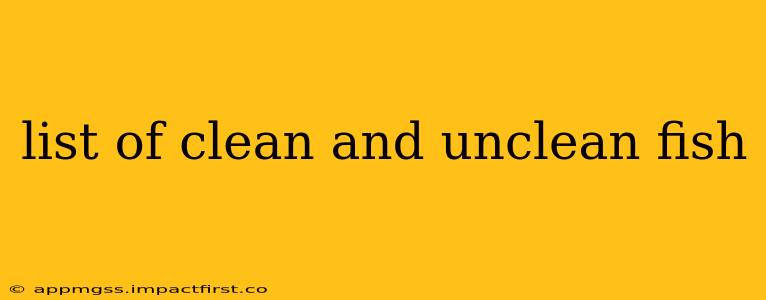The classification of fish as "clean" and "unclean" originates primarily from the Old Testament book of Leviticus, specifically Leviticus 11. This ancient dietary law, however, is not universally observed today and is interpreted differently across various religious and cultural groups. This guide will explore the biblical distinctions, their modern relevance, and factors to consider when choosing seafood.
What Makes a Fish "Clean" or "Unclean" According to Leviticus?
Leviticus 11 outlines specific criteria for determining whether a fish is clean or unclean. The key feature is the presence of fins and scales. Clean fish possess both fins and scales; those lacking either are considered unclean. This simple rule serves as the foundation for the biblical dietary laws.
Examples of Biblically Clean Fish:
Many common fish that we eat today fit this description. Examples include:
- Salmon: Possesses both fins and scales.
- Tuna: Possesses both fins and scales.
- Cod: Possesses both fins and scales.
- Trout: Possesses both fins and scales.
- Most other scaled and finned fish: The vast majority of commercially available fish fall into this category.
Examples of Biblically Unclean Fish:
Fish lacking either fins or scales are classified as unclean. This includes:
- Eels: Typically lack pelvic fins.
- Catfish: Some species have reduced or modified scales.
- Shellfish (e.g., shrimp, crabs, lobsters, oysters): Lack both fins and scales.
- Hagfish: Lack jaws, fins, and scales.
- Lampreys: Lack jaws and scales.
Why the Distinction? The Significance of Clean and Unclean Fish
The reasons behind the biblical distinction are debated. Some scholars suggest it was a way to differentiate between edible and potentially harmful fish, reflecting the limited understanding of foodborne illnesses at the time. Others propose it held symbolic or ritualistic significance.
The passage in Leviticus should be understood within its historical and cultural context. Directly applying these guidelines to modern dietary choices is not straightforward and depends heavily on individual religious interpretation.
Beyond Leviticus: Modern Considerations for Seafood Selection
While the biblical classification remains relevant to certain religious groups, modern concerns about seafood choices center around:
- Sustainability: Overfishing threatens many fish populations. Choosing sustainably sourced seafood helps protect marine ecosystems. Look for certifications like the Marine Stewardship Council (MSC) label.
- Mercury levels: Certain fish, like swordfish and king mackerel, can contain high levels of mercury. Pregnant women and young children should be particularly cautious about these fish.
- Safety and freshness: Ensure your seafood comes from reputable sources and is handled properly to prevent foodborne illness.
Are there Health Reasons to Avoid Certain Fish Today?
Yes, even apart from religious considerations, some fish may present health risks:
- High mercury content: as mentioned above.
- Potential for parasites: Raw or undercooked seafood poses a risk of parasites. Thorough cooking is crucial.
- Allergies: Seafood allergies are common.
Frequently Asked Questions
What are some examples of clean fish I can eat?
Many commonly consumed fish like salmon, tuna, cod, and trout are considered clean according to Leviticus because they have fins and scales.
Are all shellfish unclean?
Yes, according to the Levitical guidelines, all shellfish (shrimp, crabs, lobsters, oysters, etc.) are considered unclean as they lack both fins and scales.
Is it okay to eat catfish?
The classification of catfish as clean or unclean depends on the specific species and interpretation. Some species have reduced or modified scales, raising questions about their adherence to the Levitical guidelines.
Does the clean/unclean distinction apply only to fish?
No, Leviticus also outlines rules for other animals, birds, and insects, classifying them as clean or unclean for consumption.
Are there modern interpretations of the clean/unclean laws?
Yes, different religious denominations and individuals interpret these laws differently. Some adhere strictly to the original text, while others view them as superseded by the teachings of Jesus.
This guide offers a comprehensive overview of the concept of "clean" and "unclean" fish, balancing the historical and religious context with modern concerns for sustainable and safe seafood consumption. Remember to always prioritize safe food handling practices and consider both your religious beliefs and your health when choosing seafood.
